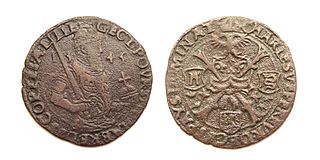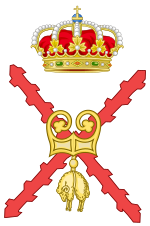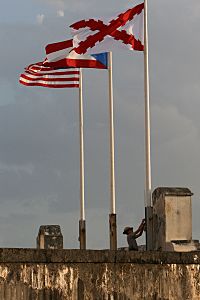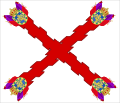Cross of Burgundy facts for kids
The Cross of Burgundy is a special kind of cross that looks like two rough, crossed branches. It's a bit like the X-shaped cross of Saint Andrew, who is the patron saint of a region called Burgundy. This cross was a very important flag and symbol used by the rulers of Burgundy and their people a long time ago.
It first appeared in the 1400s with the Dukes of Burgundy. These dukes ruled a big part of what is now eastern France and the Low Countries (like modern-day Belgium and the Netherlands). They were so powerful that their land was almost like an independent country.
Later, in 1477, the last Duke of Burgundy died. The Habsburgs, another powerful family, took over their lands. They also adopted the Cross of Burgundy as one of their many symbols. When the Habsburgs became kings of Spain in 1506, they brought this flag to the Spanish Empire. This meant the Cross of Burgundy was seen all over Europe and in the Americas where Spain had control.
Today, you can still find this emblem in many places around the world. It appears on flags, badges, and military symbols. Its wide use shows how far the influence of the Burgundian, Habsburg, and Spanish empires reached throughout history.
Contents
How Did the Cross of Burgundy Start?
Early Days in Burgundy
This special flag first appeared in the early 1400s. People who supported the Duke of Burgundy started using it to show their loyalty during a civil war in France called the Armagnac–Burgundian Civil War. The design shows the cross where Andrew the Apostle was said to have been crucified. It's a red X-shaped cross that looks like two rough, cut branches on a white background. In the language of heraldry (the study of coats of arms), it's described as a red "raguly" saltire on a silver (white) field.
Some people in the 1490s thought an earlier Duke of Burgundy chose this symbol to honor his Scottish soldiers. These Scottish soldiers were hired by John the Fearless in the early 1400s. However, older records and findings show that the cross was widely used from 1411 during fights in Paris. It's more likely it was chosen because Saint Andrew was the patron saint of the Dukes of Burgundy.
How Did It Become a Spanish Symbol?
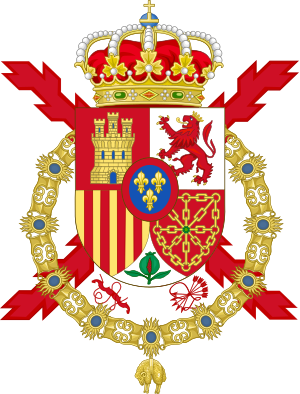
The Cross of Burgundy first appeared in Spain in 1506. It was on the flags carried by the guards of Philip the Handsome. Philip had been the Duke of Burgundy since 1482. When he married Joanna of Castile, he became the first Habsburg King of Spain. He used the Cross of Burgundy because it was a symbol of his mother's family, Mary of Burgundy.
From 1519 to 1556, Philip and Joanna's son, Emperor Charles V, ruled a huge empire. His armies used the Cross of Burgundy on different colored backgrounds. It was one of many symbols of the Habsburg family. Philip II of Spain inherited the right to use it, along with the Burgundian lands. The official background color for the flag was still white.
The Spanish Habsburg kings and later the House of Bourbon kings continued to use the Cross of Burgundy. It was even used as a supporter on the Royal Coat of Arms. From the time of King Philip V (1700–1746), the Spanish navy used a white flag with the royal coat of arms. The Burgundian flag was still used as a secondary flag until King Charles III introduced a new red-yellow-red navy flag in 1785. It also remained in use in Spain's colonies overseas.
The flag was later adopted by the Carlists, a group in Spain who wanted a different king. They fought three wars against Queen Isabella II of Spain. However, in the first Carlist War (1833–1840), the Burgundian flag was actually used by the Queen's army, not the Carlists. After 1843, the red Burgundian cross was often used on the new red-yellow army flag. During the Spanish Civil War in the 1900s, the Carlists used the Cross of Burgundy as a badge when they fought alongside the Nationalists.
Where Can You See the Cross of Burgundy Today?
Many places that use this emblem have a direct or indirect link to the old region of Burgundy or the Spanish Empire. Because the Spanish Empire was so powerful around the world, you can find many flags and coats of arms with this symbol in former Spanish territories. Most of these links are to the Spanish Empire, which spread the symbol globally.
In Spain
- It was used on merchant ships from the Biscaya region (around 1511–1830).
- It was a general Spanish merchant and privateer (pirate ship) flag before 1785.
- It is the flag of the Spanish Carlist movement, from the Spanish Civil War (1936–1939) until today.
- It was one of the official flags of Spain during the Francoist regime (1939–1975).
- In Spain, some local flags and coats of arms in areas like Guipúzcoa, Navarre, Aragón, Andalusia, Castile-La Mancha, and Catalonia still show the Cross of Burgundy.
- A Basque Nationalist flag (for example, the Basque Alpinists from 1921–1978) used a green Cross of Burgundy on white with a red border.
- Today, the Cross of Burgundy is still a symbol of the Spanish monarchy.
- The current fin flash (a symbol on the tail) of all Spanish Armed Forces aircraft (except the Navy) is a simple black and white version of the Cross of Burgundy.
- The Cross of Burgundy is on many symbols of units in the Spanish Army, like the coat of arms of the 6th Paratroopers Brigade "Almogávares".
In France
- It was used as a military flag for two infantry regiments from the Franche-Comté region of Burgundy in the late 1600s.
- During the Franco-Prussian War in 1870, local militia from Dijon wore a red Burgundian cross on their sleeve.
- People who support Burgundian regionalism in France still like the Cross of Burgundy.
- The coat of arms of the French town of Villers-Buzon has a yellow or white Burgundian cross on a wider red cross.
- The new region of Bourgogne-Franche-Comté (formed in 2015) does not use the Cross of Burgundy on its flag.
In Belgium and the Austrian Netherlands
- The flag of the Austrian Netherlands from 1781–1786 had a black double-headed eagle on a red Burgundian cross, over a red, white, and yellow background.
- It was used as a flag and badge by a far-right group in Wallonia (Belgium) since 1940, including the Walloon Legion which fought for Germany in World War II.
- It was the merchant flag and badge of the Ostend Company (Austrian Netherlands) from 1717–1731.
- The local flag and coat of arms of Philippeville (Belgium) has a yellow Burgundian cross on blue.
- The current Belgian naval ensign, which started in 1950, might be a tribute to the Cross of Burgundy.
In the Netherlands
- The Military William Order, the most important Dutch military award since 1815, has a white Maltese cross and a green Burgundian cross.
- A similar flag was used by the Seventeen Provinces of the Netherlands in the 1400s and 1500s, when they were part of the Spanish Empire.
- The flag of the Dutch town of Eijsden has a red Burgundian cross since 1966, also as a reminder of its history with Burgundy and the Spanish Empire.
In North, Central, and South America
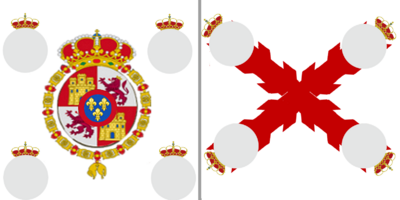
During the Spanish colonization of the Americas, the Cross of Burgundy was the flag of the Spanish territories in the New World (called Bandera de Ultramar). It was also a common symbol on flags of the Spanish military and navy. Countries that were once part of the Spanish Empire see "las aspas de Borgoña" (the Cross of Burgundy) as a historical flag. You can often see it at museums and old forts built by Spain in the 1600s and 1700s.
For example, at the San Juan National Historic Site in Puerto Rico and at Castillo de San Marcos National Monument in St. Augustine, Florida, the Cross of Burgundy is flown daily over the historic forts. These forts were built by Spain to protect its trade routes in the New World. Flying this flag today reminds people of how much Spain and its military influenced world history for over 400 years.
- In present-day Bolivia, the Cross of Burgundy (with a golden crown in the middle) is the official flag of the Chuquisaca region.
- The Flag of Valdivia in Chile, which is a red X-shaped cross on a white background, is thought to come from the Spanish Cross of Burgundy. This is because the city of Valdivia was a very important Spanish stronghold.
- The Cross of Burgundy appears on the coats of arms of the Chilean cities of Talca and Osorno.
- The Cross of Burgundy was used by some right-wing nationalist and monarchist groups in Peru after the 2021 election.
In the United States
- The flag of Alabama and flag of Florida each have a plain red X-shaped cross. This is partly to remember the time when the Spanish Cross of Burgundy was used in these areas during the colonial period.
- The Cross of Burgundy is still flown over Fort San Cristóbal and Fort San Felipe del Morro in San Juan, Puerto Rico. It also flies over the Castillo de San Marcos in St. Augustine, Florida. These are all former Spanish forts.
Gallery
-
Flag of the Quiteñan Revolution, a rebellion against Spanish authorities in Ecuador, where a flag with a reversed Cross of Burgundy was raised.
-
Coronela flag of the Spanish Tercios Morados Viejos Tercios division (old murrey or purpure)
-
Cross of Burgundy in red over a white flag was a flag of Carlism and Requetés during Francoist Spain.
-
Flag and royal standard of New Spain.
See also
 In Spanish: Cruz de Borgoña para niños
In Spanish: Cruz de Borgoña para niños
- History of Spain
- Burgundy (disambiguation)
- Saint Patrick's Flag
- Vexillology



